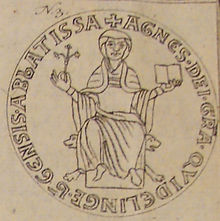Agnes II, Princess-Abbess of Quedlinburg
| Agnes II | |
|---|---|

Agnes II's seal
|
|
| Princess-Abbess of Quedlinburg | |
| Reign | 1184–1203 |
| Predecessor | Adelaide III |
| Successor | Sophia |
| Born | 1139 Meissen |
| Died | 1203 Quedlinburg Abbey |
| Father | Conrad, Margrave of Meissen |
| Mother | Luitgard of Swabia |
| Religion | Roman Catholic |
Agnes II (Agnes of Meissen; 1139–1203) was a member of the House of Wettin who reigned as Princess-Abbess of Quedlinburg.
She was born is Meissen as the daughter of Conrad, Margrave of Meissen, and Luitgard of Swabia. In 1184, she was elected successor to Princess-Abbess Adelaide III.
Agnes was a significant patron of art, as well as miniaturist and engraver. During her reign, the nuns of Quedlinburg Abbey made large curtains which still exist and which are valuable in the study of the art industry of the era. She wrote and illuminated books for divince service with her own hands. However, her greatest masterpiece was the manufacture of wall-hangings, of which one set was intended to be sent to the Pope; this tapestry is the best preserved piece of Romanesque textile.
She died in Quedlinburg Abbey on 21 January 1203.
Agnes is a featured figure on Judy Chicago's installation piece The Dinner Party, being represented as one of the 999 names on the Heritage Floor.
...
Wikipedia
